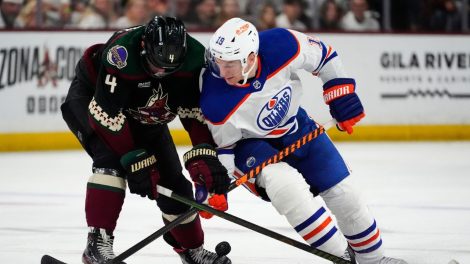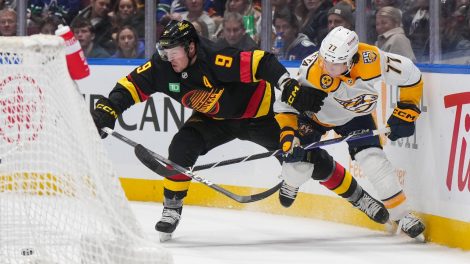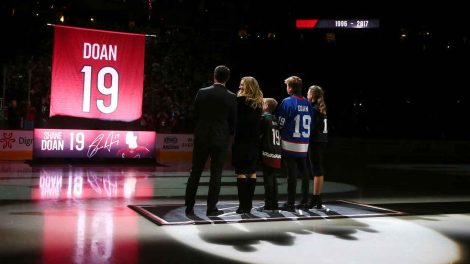TORONTO – For all the chatter about the Toronto Maple Leafs’ weaknesses in this October to forget, it’s the recent failing of one of their supposed strengths that may be most confounding.
“Holy God, there was a lot of penalties,” said head coach Mike Babcock, his eyes scanning the game sheet following Tuesday’s 4-3 overtime loss, Toronto’s third loss in four outings.
Fifteen penalties all told. And the side that took best advantage of the extra man on the ice — as is so often the case in a league that prides itself on parity — came out victorious.
[snippet id=4748264]
Babcock called a rare timeout late in the first period when the Capitals committed consecutive minors, gifting the home team an opportunity to seize hold of the night with a 5-on-3.
Employing their seldom-practised two-defenceman formation (Tyson Barrie joining Morgan Rielly on PP1), the Leafs’ 5-on-3 failed to muster so much as a shot on net.
Conversely, when the Washington was granted its own 5-on-3 in the second period, John “Hand Out the Norris Now” Carlson needed all of six seconds to bury the fruit of a clean offensive-zone faceoff won against winger(!) Mitch Marner and give the visitors the lead.
Though Toronto’s Auston Matthews eventually did convert on a third-period power play and force overtime, the Leafs scored just once on eight attempts with a Cap in the box.
“It helps when you capitalize on those power plays,” Matthews said. “It gives you a little bit of momentum, a little bit of a jump, and we didn’t really capitalize on one until the third period.”
[snippet id=4167285]
Meanwhile, Washington went two-for-seven, getting back-to-back power-plays in OT thanks to infractions by William Nylander and Marner.
Alex Ovechkin teed up his second blast of the game to seal the deal from his circular office.
“Obviously, the boys know,” Ovechkin said. “If I’m wide open, I’m there.”
Special teams were the difference in a contest overrun with odd-man situations.
“It was hard to get in the groove for some guys,” Marner said. “It’s just unfortunate how it ended.”
Toronto, you may recall, lost its last adventure into 3-on-3 by giving Columbus a penalty shot.
The Leafs haven’t won the special-teams battle in seven straight games now. The Capitals rank seventh-overall in both the PK and PP, a contributing factor to their standing atop the Eastern Conference.
“Anytime you give a team like that four straight minutes on the power play, they’ll make you pay,” Barrie lamented.
That is supposed to be something opponents say about the Maple Leafs, whose power play has now slunk to 18th overall, converting at a 19.6 per cent success rate.
Their revamped penalty kill, rated 23rd overall (77.1 per cent), isn’t much better off.
It’s a bit of a head-scratcher that odd-man situations are a recurring issue for a skills-heavy group that should logically be thriving with extra time and space to flex their creativity.
To be fair, both units are missing key personnel. John Tavares (finger) is the experienced, effective man in the middle on Toronto’s $41.9-million top unit. Zach Hyman (knee) and now Jake Muzzin (charley horse) can assist with kills.
“The way we’ve been injury-wise this year, we haven’t had two units like we’d like to,” Babcock said. “We’d like to have one group that goes out there for a 1:10 or whatever, and the other group comes and shoots it in the net anyways.”
Special teams were an established Achilles heel in the Leafs’ growing-pains losses to Boston in the post-season, and GM Kyle Dubas made it an effort to address them over the summer, replacing both Babcock’s assistants with the best candidates available.
Under new Leafs assistant Paul McFarland, the 2018-19 Florida Panthers ran the deadliest PP in the league. McFarland made some intriguing tweaks to what had become a “stale” (Matthews’s word) setup, switching Marner and Matthews to their off wings for one-timer opportunities and plopping the greasy Andreas Johnsson net-front.
McFarland also offered the Plan B option of the two-D setup, incorporating Barrie, who’s seen his individual time with the man-advantage dwindle since leaving Colorado. And his offensive production has followed suit.
“We just did the math,” Babcock explained of prioritizing Rielly. “We said, ‘Mo’s a 70-point guy.’ Mo’s one of the best players in hockey. I’m not trying to take anything away from anybody else. That’s just the situation.”
A situation Barrie, a 59-point guy, is still adapting to.
“It’s a different role for me this year,” said the defenceman, finally snapping his 10-game scoring drought with an assist Tuesday. “When you’re not on that first unit, you’re not getting as many touches as you would and not feeling the puck quite as much. So, just trying to work around that and find out where I fit in.”
It’s right back to work Wednesday, as Babcock is welcoming three consecutive days to rest, reset, say a prayer for Tavares’s finger, and, no doubt, try to shape these sagging special teams.
“We’ll watch it tomorrow and probably work on it in practice,” Rielly said.
“That’s an area we want to improve on.”
All the power to them.
[relatedlinks]









